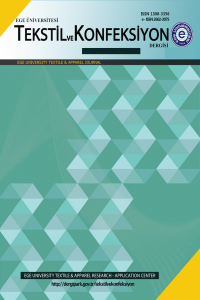SENTETİK ATIK SULARDAN BOYAR MADDELERİN KİTOSAN, ÇAPRAZ BAĞLI KİTOSAN VE KİTOSAN-POLİ (AKRİLİK ASİT) KONJUGATI İLE GİDERİLMESİ
Boyar madde, Giderme, Kitosan, Konjugat, Mikrodalga, Poli (akrilik asit)
DYESTUFFS REMOVAL FROM SYNTHETIC WASTEWATER WITH CHITOSAN, CROSS-LINKED CHITOSAN AND CHITOSAN-POLY (ACRYLIC ACID) CONJUGATE
___
- 1. Yaman, Y.C, Gündüz, G., Kumbasar, E.P.A., 2010, "The treatment of waste water of dyeing by fenton oxidation in presence and absence of ultrasound", Tekstil ve Konfeksiyon. 20, pp. 348–358.
- 2. Eren H.A., Yildiz, D., Demir, C., Şahin, S., 2013, "Color removal of disperse blue dyes by ozonation", Tekstil ve Konfeksiyon. 23, pp. 267–272.
- 3. Karatas, M., Dursun, S., Argun, M.E., 2010, "The Decolorization of Azo Dye Reactive Black 5 in a Sequential Anaerobic-Aerobic System", Ekoloji. 19, pp. 15–23.
- 4. Yagub, M.T., Sen, T.K., Afroze, S., Ang, H.M., 2014, "Dye and its removal from aqueous solution by adsorption: A review", Advanced Colloid Interface Science. 209, pp. 172–184.
- 5. Deveci, T., Unyayar, A., Mazmanci, M.A., 2004, "Production of Remazol Brilliant Blue R decolourising oxygenase from the culture filtrate of Funalia trogii ATCC 200800", Journal of Molecular Catalysis. B Enzyme, 30, pp. 25–32.
- 6. Onder, S., Celebi, M., Altikatoglu, M., Hatipoglu, A., Kuzu, H., 2011, "Decolorization of naphthol blue black using the horseradish peroxidase", Applied Biochemistry and Biotechnology, 163, pp. 433–443.
- 7. Song, S., Yao, J., He, Z., Qiu, J., Chen, J., 2008, "Effect of operational parameters on the decolorization of C.I. Reactive Blue 19 in aqueous solution by ozone-enhanced electrocoagulation", Journal of Hazardous Materials, 152, pp. 204–210.
- 8. Celebi, M., Altikatoglu, M., Akdeste, Z.M., Yildirim, H., 2013, "Determination of decolorization properties of Reactive Blue 19 dye using Horseradish Peroxidase enzyme", Turkish Journal of Biochemistry, 38, pp. 200–206.
- 9. Vakili, M., Rafatullah, M., Salamatinia, B., Abdullah, A.Z., Ibrahim, M.H., Tan, K.B., Gholami, Z., Amouzgar, P., 2014, "Application of chitosan and its derivatives as adsorbents for dye removal from water and wastewater: A review", Carbohydrate Polymers, 113, pp. 115–130.
- 10. Guibal, E., Roussy, J., 2007, "Coagulation and flocculation of dye-containing solutions using a biopolymer (Chitosan)", Reactive and Functional Polymers, 67, pp. 33–42.
- 11. Petzold, G., Schwarz, S., 2006, "Dye removal from solutions and sludges by using polyelectrolytes and polyelectrolyte-surfactant complexes", Seperation and Purification Technology, 51, pp. 318–324.
- 12. Crini, G., Badot, P.M., 2008, "Application of chitosan, a natural aminopolysaccharide, for dye removal from aqueous solutions by adsorption processes using batch studies: A review of recent literature", Progressive Polymer Science, 33, pp. 399–447.
- 13. Yazdani, M., Bahrami, H., Arami, M., 2014, "Feldspar/titanium dioxide/chitosan as a biophotocatalyst hybrid for the removal of organic dyes from aquatic phases", Journal of Applied Polymer Science, 131, pp. 1–9.
- 14. Jabli, M., Aloui, F., Ben Hassine, B., 2013, "[ Copper ( II )/ Cellulose-Chitosan ] Microspheres Complex for Dye Immobilization : Isotherm , Kinetic and Thermodynamic Analysis", Journal of Engineered. Fibers and Fabrics. 8, pp. 19–34.
- 15. Chen, Y., He, F., Ren, Y., Peng, H., Huang, K., 2014, "Fabrication of chitosan/PAA multilayer onto magnetic microspheres by LbL method for removal of dyes", Journal of Chemical Engineering, 249, pp. 79–92.
- 16. Nüchter, M., Ondruschka, B., Bonrath, W., Gum, A., 2004, "Microwave assisted synthesis - a critical technology overview", Green Chemistry, 6, pp. 128– 141.
- 17. Michael, D., Mingos, P., Baghurst, D.R., 1991, "Applications of Microwave Dielectric Heating Effects to Synthetic Problems in Chemistry", Chemical Society Reviewers, 20, pp. 1-47.
- 18. Baig, R.B.N., Varma, R.S., 2012., "Alternative energy input: mechanochemical, microwave and ultrasound-assisted organic synthesis", Chemical Society Reviewers, 41, pp. 1559-1584.
- 19. Gedye, R., Smith, F., Westaway, K., Ali, H., Baldisera, L., Laberge, L., Rousell, J., 1986, "The use of microwave ovens for rapid organic synthesis", Tetrahedron Letters. 27, pp. 279–282.
- 20. Polshettiwar, V., Varma, R.S., 2008, "Microwave-Assisted Organic Synthesis and Transformations using Benign Reaction Media", ACS, Accounts Chemical Resources, 41, pp. 629-639.
- 21. Jiang, X., Cai, K., Zhang, J., Shen, Y., Wang, S., Tian, X., 2011, "Synthesis of a novel water-soluble chitosan derivative for flocculated decolorization", Journal of Hazardous Materials, 185, pp. 1482–1488.
- 22. Renault, F., Sancey, B., Badot, P.M., Crini, G., 2009, "Chitosan for coagulation/flocculation processes - An eco-friendly approach", Journal of European Polymers, 45, pp. 1337–1348.
- ISSN: 1300-3356
- Yayın Aralığı: Yılda 4 Sayı
- Başlangıç: 1991
- Yayıncı: Ege Üniversitesi
Mithat ÇELEBİ, Zafer Ömer ÖZDEMİR
DÜZ ÖRME SANDVİÇ KUMAŞLARIN TERMO-FİZYOLOJİK KONFOR VE NEM İLETİM ÖZELLİKLERİNİN ANALİZİ
TEK ADIMDA MULTIFONKSIYONEL PAMUKLU DOKUMA KUMAŞ ÜRETİMİ
Şule SOYKAN, Necdet SEVENTEKİN, Esen ÖZDOĞAN, Zehra KOCATÜRK
SÜRDÜRÜLEBİLİR KISA LİF İPLİK TEKNOLOJİSİ İÇİN GERİ DÖNÜŞÜM PAMUK VE POLYESTER LİFLERİNİN KULLANIMI
Abdurrahman TELLİ, Osman BABAARSLAN
Shoaib IQBAL, Moaz ELDEEB, Zuhaib AHMAD, Adnan MAZARI
KALİTE KONTROLDE YANIT YÜZEY DESENLERİ: İPLİK DÜZGÜNSÜZLÜĞÜ ÖRNEĞİ
Nefise Gönül ŞENGÖZ, Pınar ARSLAN
EFFECT OF MERCERIZATION FOLLOWED BY CROSS-LINKING ON COTTON FABRIC PROPERTIES
Abdelhamid Rajab Ramadan ABOALASAAD, Brigita Kolcavova SIRKOVA, Abdel-latif Mohamed EL-HOSSINI, Ali HEBEISH
Mehmet KERTMEN, Seher KANAT, Turan ATILGAN
PAMUKLU KUMAŞLARIN BASILMASI İÇİN FARKLI DOĞAL BOYARMADDE KAYNAKLARININ KULLANILMASI
M. İbrahim BAHTİYARİ, Hüseyin BENLİ, Arzu YAVAŞ, Candan AKÇA
